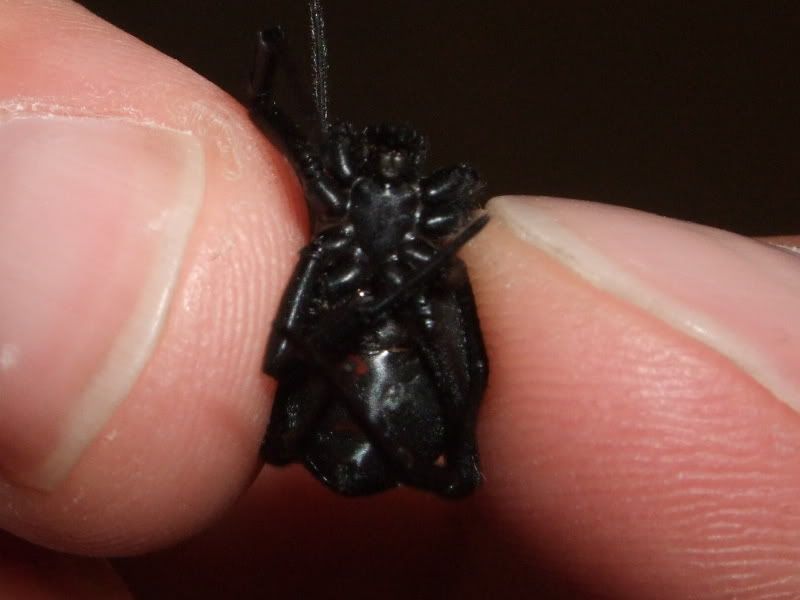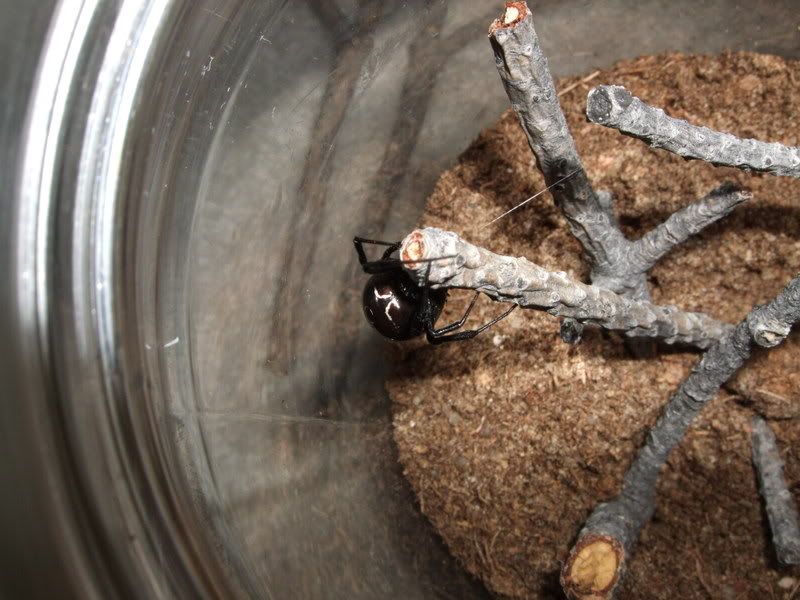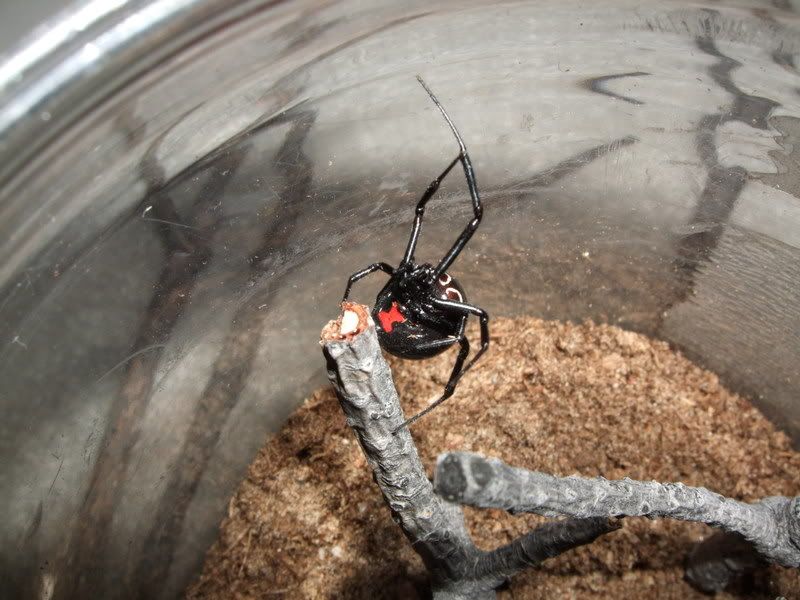- Joined
- Jan 25, 2007
- Messages
- 4,209
now, before i get started, these are GENERALIZATIONS about the patterns found on the north american widow species. these are by no means foolproof, or a good way to identify species- as will be shown at the end. these are merely observations coupled with pictures. they hold true in most instances. i know this information can probably be found elsewhere on the web too. anyway, hopefully this is somewhat informative or even entertaining for those who know much more than me and can provide better information and pictures 
let's start out with my favorite black, Latrodectus hesperus, the western black widow. this species is the posterboy for black widows. jet black all over, no dorsal markings or patterns, and a great looking glass. the glass is fairly symmetrical, though sometimes just a line. the top half of the glass is solid in almost all cases. and many times, the bottom half of the glass is a mirror image. either way, whether it be a perfect glass, or a line, or whatever, the two parts are connected- no gaps. here are a few images to demonstrate:
a good looking, connected glass:

the line/bar:

faded bottom half of glass, still very characteristic of hesperus:

let's now move on to my favorite widow species of all time, Latrodectus bishopi, the red widow. this species is heavily dorsally patterned, with beautiful ringed spots on the back of the abdomen. anyway, glasses are being discussed here! this species has only the top half of the glass, and it is somewhat squished. the bottom half is absent. here is a couple pics to demonstrate:


next up is the characteristic Latrodectus geometricus, the brown widow- found worldwide. this species is different because the glass is orange, not red. it also has a good looking glass that is connected. the top half of the glass is very good, and the bottom half is an exact mirror image, only enlarged a bit. the bottom is just a little bigger than the top, but looks the same. also, the species can be distinguished by the yellow dots surrounding the spinnerets. here's some examples:


moving on, we have Latrodectus mactans, the southern black widow. mactans sometimes have light dorsal patterning, mostly just a solid red dot near the spinnerets. for the glass, again, it is usually connected. the top half of the glass is normal, but the bottom makes it different. the bottom half is typically 'chunky,' or blocklike. it does not look like a triangle, but a block. here is what i mean:
showing the block, or squished:

another, reminds me of the symbol for the university of tennessee:

lastly, we come to Latrodectus variolus, the northern black widow. this species has dorsal markings, much more so than mactans, usually a stripe or series of dots. the glass is separated, different from the other blacks. the top half of the glass is a nice triangle. a good space is between the two pieces, the bottom piece being like a triangle that had the pointy part chopped off. don't know how quite to describe it better. here are a couple of pics:


and just to show that hourglasses CANNOT be used to identify a species 100%, here are a couple of pics:
weird glass, actually from a mactans:

and no glass at all, from a hesperus:

well, i hope somebody learned something from this. again, these are rough generalizations about patterns found on our N.A. species. oh- and all these pics are mine btw.
and a BIG THANK YOU to a certain member (you know who you are) for providing me with so many widows, you've been so generous to me, i won't forget it :clap:
let's start out with my favorite black, Latrodectus hesperus, the western black widow. this species is the posterboy for black widows. jet black all over, no dorsal markings or patterns, and a great looking glass. the glass is fairly symmetrical, though sometimes just a line. the top half of the glass is solid in almost all cases. and many times, the bottom half of the glass is a mirror image. either way, whether it be a perfect glass, or a line, or whatever, the two parts are connected- no gaps. here are a few images to demonstrate:
a good looking, connected glass:

the line/bar:

faded bottom half of glass, still very characteristic of hesperus:

let's now move on to my favorite widow species of all time, Latrodectus bishopi, the red widow. this species is heavily dorsally patterned, with beautiful ringed spots on the back of the abdomen. anyway, glasses are being discussed here! this species has only the top half of the glass, and it is somewhat squished. the bottom half is absent. here is a couple pics to demonstrate:


next up is the characteristic Latrodectus geometricus, the brown widow- found worldwide. this species is different because the glass is orange, not red. it also has a good looking glass that is connected. the top half of the glass is very good, and the bottom half is an exact mirror image, only enlarged a bit. the bottom is just a little bigger than the top, but looks the same. also, the species can be distinguished by the yellow dots surrounding the spinnerets. here's some examples:


moving on, we have Latrodectus mactans, the southern black widow. mactans sometimes have light dorsal patterning, mostly just a solid red dot near the spinnerets. for the glass, again, it is usually connected. the top half of the glass is normal, but the bottom makes it different. the bottom half is typically 'chunky,' or blocklike. it does not look like a triangle, but a block. here is what i mean:
showing the block, or squished:

another, reminds me of the symbol for the university of tennessee:

lastly, we come to Latrodectus variolus, the northern black widow. this species has dorsal markings, much more so than mactans, usually a stripe or series of dots. the glass is separated, different from the other blacks. the top half of the glass is a nice triangle. a good space is between the two pieces, the bottom piece being like a triangle that had the pointy part chopped off. don't know how quite to describe it better. here are a couple of pics:


and just to show that hourglasses CANNOT be used to identify a species 100%, here are a couple of pics:
weird glass, actually from a mactans:

and no glass at all, from a hesperus:

well, i hope somebody learned something from this. again, these are rough generalizations about patterns found on our N.A. species. oh- and all these pics are mine btw.
and a BIG THANK YOU to a certain member (you know who you are) for providing me with so many widows, you've been so generous to me, i won't forget it :clap:
Last edited:





